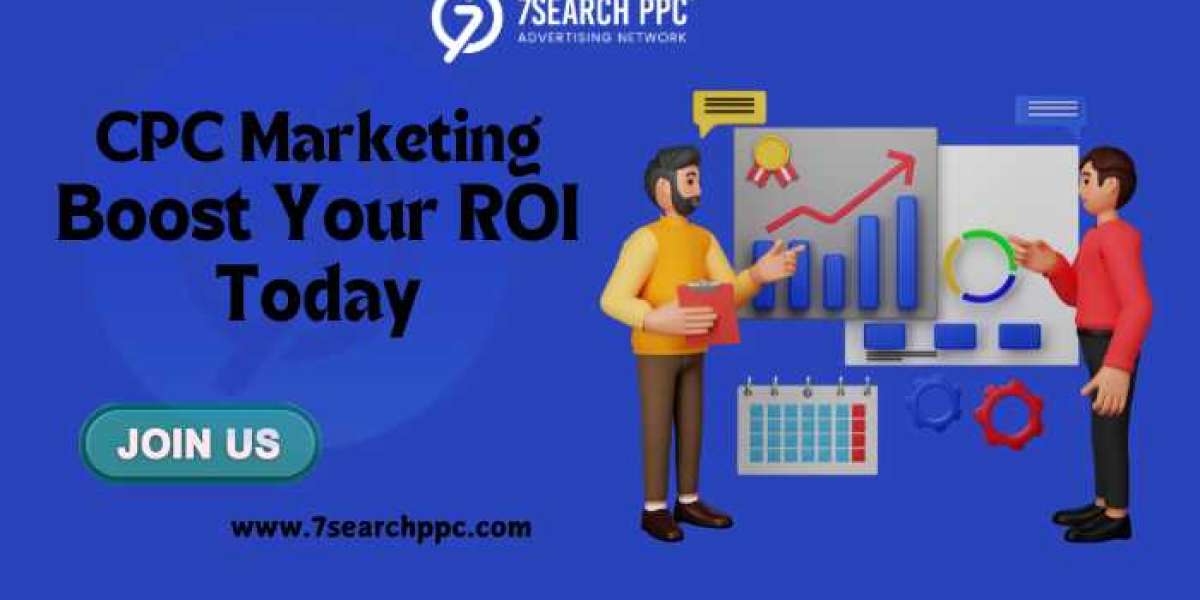In today's fast-paced digital marketing landscape, businesses constantly seek strategies to maximize their return on investment (ROI) while driving targeted traffic to their websites. Cost-per-click (CPC) marketing has emerged as one of the most effective solutions for achieving these goals. In this comprehensive guide, we'll explore how CPC marketing works, its benefits, and how it compares to other advertising models like cost-per-impression (CPM) or cost-per-acquisition (CPA).

What is CPC Marketing?
CPC marketing, also known as Pay-Per-Click (PPC) marketing, is an online advertising model where advertisers pay a fee each time one of their ads is clicked. Essentially, it's a way of buying visits to your website, rather than attempting to “earn” those visits organically. Advertisers use this model to drive targeted traffic to their sites, aiming to convert those clicks into valuable actions such as sales, sign-ups, or leads.
How Does CPC Marketing Work?
CPC marketing revolves around advertising platforms like Google Ads or Bing Ads. Advertisers bid on keywords that are relevant to their products or services, and their ads are displayed on search engine results pages (SERPs) or across the internet. The bid amount plays a crucial role in determining the ad's placement. However, it's not just about how much you're willing to pay; relevance and quality scores also influence the positioning of your ad.
Here’s a breakdown of how the process works:
- Keyword Research: Advertisers begin by conducting in-depth keyword research to determine the best terms to target. Tools like Google Keyword Planner or SEMrush are invaluable in finding keywords that balance search volume with cost.
- Ad Creation: Once the keywords are chosen, advertisers craft compelling ad copy that speaks to the intent behind those searches. A well-written ad can significantly increase click-through
- Ad Auction: When users enter search queries related to the chosen keywords, the ad enters an auction with other advertisers bidding on the same terms. The outcome of this auction determines where your ad will appear on the search results page. However, this placement isn’t solely determined by the highest bid; search engines also factor in your Quality Score—a combination of ad relevance, expected click-through rate, and landing page experience.
- Clicks and Costs: If a user clicks on your ad, you're charged based on the bid amount. This means you're only paying when a user is genuinely interested in what you're offering.
- Conversion Tracking: Advertisers closely monitor user behavior after a click. Conversion tracking allows them to see whether the user completed a desired action, such as making a purchase or filling out a contact form. This helps marketers assess the effectiveness of their campaigns and optimize accordingly.
The Benefits of CPC Marketing
CPC marketing has proven to be a versatile and powerful tool for businesses across industries. Here’s why it’s so effective:
Targeted Traffic
One of the main advantages of CPC marketing is its ability to drive highly targeted traffic. Through keyword targeting, advertisers can attract users who are actively searching for their products or services. Additionally, platforms like Google Ads allow for more granular targeting options such as location, demographics, and device usage, ensuring that your ads reach the right audience at the right time.
Cost-Effectiveness
Unlike traditional advertising methods, CPC marketing ensures that your budget is spent efficiently. You're only charged when someone clicks on your ad, meaning every dollar is used to attract potential customers. This makes it a cost-effective solution for businesses of all sizes, as you control your spending through budget limits and bidding strategies.
Measurable ROI
CPC campaigns offer detailed analytics that help advertisers measure their return on investment (ROI). Marketers can track every click and conversion, enabling them to optimize their campaigns for better performance. This data-driven approach ensures that advertisers can make informed decisions and continuously improve their campaigns.
Instant Results
Compared to organic search engine optimization (SEO), which can take months to show results, CPC marketing provides almost instant visibility. Once your campaign is set up and running, your ads can appear on search engine results pages (SERPs) almost immediately, allowing you to start driving traffic to your website without delay.
CPC vs. Other Advertising Models
To fully understand the value of CPC marketing, it's important to compare it with other common online advertising models:
CPC vs. CPM (Cost-Per-Impression)
In a CPM model, advertisers pay for every 1,000 impressions their ad receives, regardless of whether users interact with the ad. While this can be useful for building brand awareness, it doesn't guarantee engagement. On the other hand, CPC marketing ensures that you're only paying for users who show genuine interest by clicking on your ad.
For businesses focused on driving traffic and conversions, CPC is generally a more cost-effective choice than CPM.
CPC vs. CPA (Cost-Per-Acquisition)
With the CPA model, advertisers are charged only when a user completes a specific action, such as making a purchase or signing up for a service. While CPA guarantees results, it often comes at a higher cost because advertisers are paying for actual conversions rather than just clicks. CPC marketing, however, offers a more balanced approach, allowing advertisers to generate traffic at a lower cost while still tracking conversions to optimize their campaigns.
Leveraging Native Ads Platforms for CPC Campaigns
While search engine-based CPC marketing is a proven strategy, expanding your efforts to Native Ads Platforms can further enhance your campaign’s reach and effectiveness.
What are Native Ads Platforms?
Native ads are designed to blend seamlessly with the content of the platform on which they appear. Unlike traditional display ads, which can be disruptive and often ignored by users, native ads are integrated into the user experience, making them less intrusive and more engaging. Platforms such as Taboola, Outbrain, and Revcontent are popular choices for native advertising.
Why Use Native Ads Platforms for CPC Marketing?
Native ads work well in conjunction with CPC strategies because they offer a unique opportunity to target users with more personalized and relevant content. This type of advertising is particularly effective for businesses looking to drive awareness while still maintaining performance-based metrics, such as click-through rates and conversions. Native ads also typically generate higher engagement rates because they feel more organic to users, making them more likely to click through.
How PPC Ad Networks Support CPC Campaigns
In addition to search engines and native ad platforms, PPC Ad Networks are another critical component of a well-rounded CPC marketing strategy. These networks connect advertisers with publishers to display ads across a variety of websites. Here’s how they can benefit your campaigns:
Broader Reach
PPC ad networks, like Google Display Network or Bing Ads, offer access to a vast number of websites and apps. This allows advertisers to display their ads to a much wider audience, expanding their potential customer base beyond just search engine users.
Cross-Device Targeting
Many PPC ad networks offer cross-device targeting, enabling advertisers to reach users across desktops, tablets, and mobile devices. With the increasing number of users browsing the web on multiple devices, this feature ensures that your ads are being seen by potential customers wherever they are.
Performance Optimization
PPC ad networks provide a range of tools for performance optimization, including A/B testing, audience segmentation, and automated bidding strategies. These features help advertisers get the most out of their campaigns by identifying what works and what doesn’t, and allowing for real-time adjustments to improve results.
Best Practices for a Successful CPC Marketing Campaign
To get the most out of your CPC campaigns, follow these best practices:
Conduct Thorough Keyword Research
Start by identifying high-performing keywords that align with your audience’s search intent. Use tools like Google Keyword Planner or Moz Keyword Explorer to find keywords that offer a good balance between search volume and competition.
Create Compelling Ad Copy
Your ad copy should be clear, concise, and relevant to the user’s search query. Highlight the unique selling points of your product or service, and use strong calls-to-action (CTAs) to encourage clicks.
Optimize Landing Pages
Ensure that your landing pages are optimized for conversions. They should load quickly, be mobile-friendly, and provide users with the information they were promised in the ad. An effective landing page can significantly improve your conversion rates.
Monitor and Adjust Bids
Regularly monitor your bids and adjust them based on performance. Automated bidding strategies, such as Target CPA or Maximize Clicks, can help you get the most out of your budget while ensuring that you remain competitive in the ad auctions.
Analyze Data and Make Improvements
Use the detailed analytics provided by platforms like Google Ads to track the success of your campaigns. Pay attention to metrics like click-through rate (CTR), conversion rate, and cost per conversion to identify areas for improvement.
Conclusion
CPC marketing is a powerful tool for businesses looking to drive targeted traffic and maximize their ROI. By only paying for actual clicks, advertisers can ensure that their marketing budgets are spent efficiently and effectively. Whether you’re using traditional search engine PPC, expanding to native ads platforms, or leveraging PPC ad networks, CPC marketing offers a flexible and results-driven approach to online advertising.








